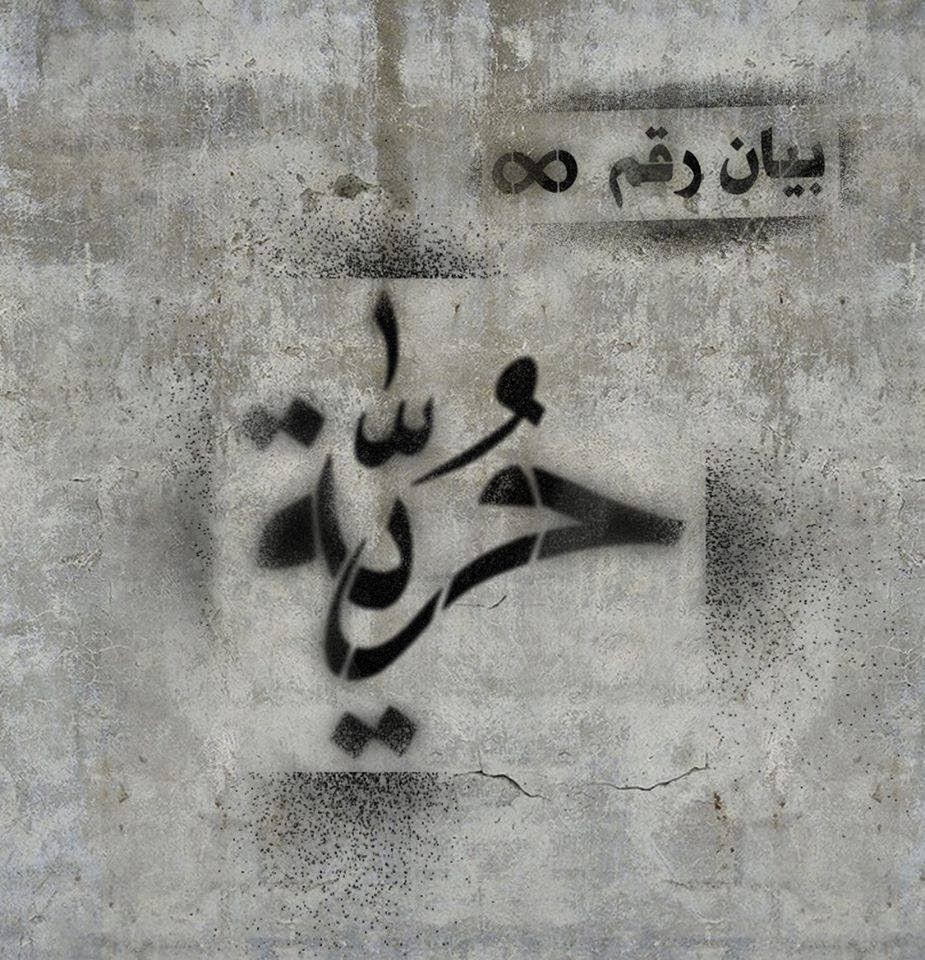"Walls: The Books of the Revolution"
 |
| Juan Zero, Graffiti, 29.4.2012. |
We have seen him before on this blog, the spray man above, drawn on the day the 23-year old Nour Hatem Zahra was shot in the leg by the Assad regime and bled to death.
His spray colleagues let him merge into the walls, making his portrait not just an icon of freedom, but an artwork in itself.
 |
| Photo courtesy of Tarek Alghorani. |
It is a constant eyeopener how the stenciled faces of the martyrs are the very essence of grasping a likeness. Deceptively simple, they have intensity and are immediately recognizable at the one and same time. They are not contoured as such. They are composed of heavy shadowing on certain parts of the face, although in the instance of Nour Hatem Zahra his cheek and chin are given a contour because of the leaning of his head, underlining the softly rounded youth tending towards the beholder.
Every detail has to be connected to the rest of the image in order not to be cut away when the stencil is created, which takes some planning. In order not scare anyone away from doing their own, in that as many as possible are needed, Tarek Alghorani and his colleagues made videos on how to strengthen the paper with tape and then get to it. Accompanied by music with a certain drive to it to remove any remaining restraint:
Tareq Samman: http://www.youtube.com/watch?v=1D7dj7GHuYI
It is unmistakably Nour Hatem Zahra we see below. And yes, he is first and foremost meant to be recognized while passing him by in the street, but recognition has all through history been the very definition of the image of a ruler:
 |
| Photo courtesy of Tarek Alghorani. |
Assad is as transparent in person, as his portrait was to be seen everywhere. To the world outside he seemed to embrace the new century with its social media. A cartoonist even seemed to be favoured. Ali Ferzat was allowed to create his own magazine and when the neighbouring countries complained of the drawings therein, Assad would each time grow a little in the eyes of the world.
All the while the bloggers and journalists were being tortured in prison. Ali Ferzat was in trouble himself, but even to his countrymen he still seemed to be in favor. Until the first graffiti artists took to the streets, and Assad had to reveal his real face.
The autocrat is a helpless person
Has no ability nor power but his succours
Enemies of justice, allies of oppression
(Al Kawakibi, Syrian author 1849 - 1902)
 |
| "It is the day of Civil Strike. There is no justification for keeping silent after today" Translation: Center for Kultur og Udvikling: Syria's Art of Resistance.
Foto: Tony Daoud, 2013.
|
It is notable how the stencils do not call for violence nor do they show any. Those killed by the regime are not shown battered or tortured in death, but remain the vibrant and intelligent persons they were in life.
 |
| "Civil Strike! I will not obey a government that has lost its legitimacy" Translation: Center for Kultur og Udvikling: Syria's Art of Resistance.
Foto: Tony Daoud, 2013.
|
The moral superiority belongs to the graffiti artists. The one to the right, which is also to be found as a stencil is my personal favorite. A symbol of prohibition to ensure that order is maintained. Movement is not allowed, but then one part is being removed, movement within the immobility, and all of a sudden we have an image of civil disobedience:
Assad has reacted blindly like rulers before him have done in history. They ban the access to the means to communication, paper for instance, or in this instance the spray can. An identity card has to be shown when buying one. Only, yet again the protesters knew how to organize solutions. A cola bottle and the air from a wheel:
"Not freedom but dignity
Dignity in the simplest forms
There is a famous clip of a soldier hit one people and say to him: You want freedom?
And beat him and say to him: this is for freedom
For what?
Freedom
Despite the lack of freedom
People are looking for dignity"
Tarek speaks of the walls as carriers of action and hope:
Walls in all cities, squares and neighborhoods
Was written over or painted black
Effacement in black after we had drawn on the full wall all night
Especially after we had drawn the flag of the Revolution for long distances - more than 10 meters -
Then Assad had the walls broken down by (his thugs) shabeeha ......
And went on to work erratically
A campaign, which was scheduled to be a week
lasted more than 4 months unabated
Only when he began to demolish the walls I stopped
When the system was killed activists I continued
When the walls were demolished I stopped
It struck with me horror
I did not discover it until later"
When the system was killed activists I continued
When the walls were demolished I stopped
It struck with me horror
I did not discover it until later"
"The streets to us
Walls to us
We the People
And on the walls
We will paint
express ourselves
And raise our voice
Walls: the books of the revolution
Free peoples' books
Art of the system (with the dots in red and green, for the blood or love and the holy colour, respectively)
April 14-21, 2012
Art of the system (with the dots in red and green, for the blood or love and the holy colour, respectively)
April 14-21, 2012
Graffiti for freedom"
http://www.youtube.com/watch?v=BQ48lAjxnEw



